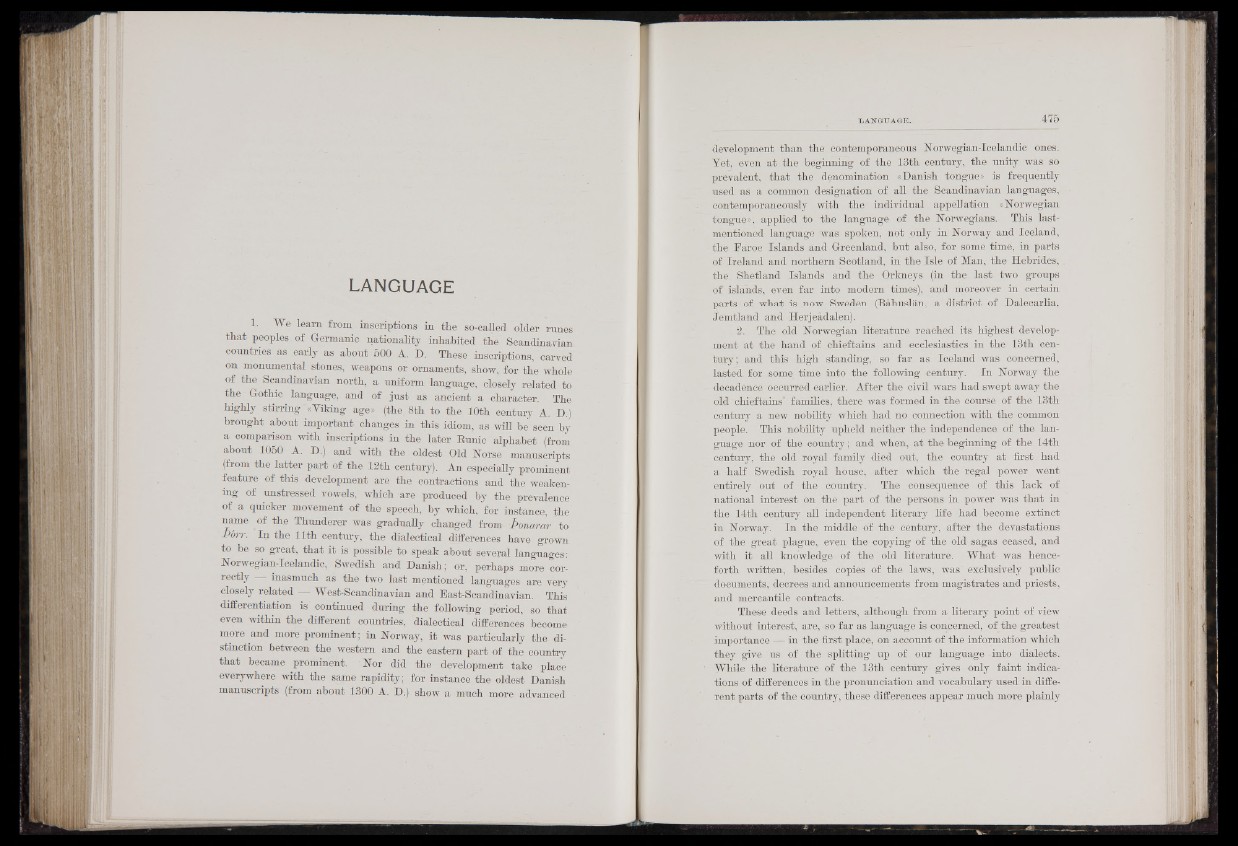
LANGUAGE
1. We learn from inscriptions in the so-called older runes
that peoples of Germanic nationality inhabited the Scandinavian
countries as early as about 500 A. D. These inscriptions, carved
on monumental stones, weapons or ornaments, show, for the whole
of the Scandinavian north, a uniform language, closely related to
the Gothic language, and of just as ancient a character. The
highly stirring «Viking age» (the 8th to the 10th century A. D.)
brought about important changes in this idiom, as will be seen by
a comparison with inscriptions in the later Runic alphabet (from
about 1050 A. D.) and with the oldest Old Norse manuscripts
(from the latter part of the 12th century). An especially prominent
feature of this development are the contractions and the weakening
of unstressed vowels, which are produced by the prevalence
of a quicker movement of the speech, by which, for instance, the
name of the Thunderer was gradually changed from l>onorar to
Póìr. In the 11th century, the dialectical differences have grown
to be so great, that it is possible to speak about several languages:
Norwegian-Icelandic, Swedish and Danish ; or, perhaps more corr
e c t l y inasmuch as the two last mentioned, languages are very
closely related est-Scandinavian and East-Scandinavian. This
differentiation is continued during the following period, so that
even within the different countries, dialectical differences become
more and more prominent; in Norway, it was particularly the distinction
between the western and the eastern part of the country
that became prominent. Nor did the development take place
everywhere with the same rapidity; for instance the oldest Danish
manuscripts (from about 1300 A. D.) show a much more advanced
development than the contemporaneous Norwegian-Icelandic ones.
Yet, even at the beginning of the 13th century, the unity was so
prevalent, that the denomination «Danish tongue» is frequently
used as a common designation of all the Scandinavian languages,
contemporaneously with the individual appellation «Norwegian
tongues, applied to the language of the Norwegians.- This last-
mentioned language ‘was spoken, not only in Norway and Iceland,
the Faroe Islands and Greenland, but also, for some time, in parts
of Ireland and northern Scotland, in the Isle of Man, the Hebrides,
the Shetland Islands and the Orkneys (in the last two groups
of islands, even far into modern times), and moreover in certain
parts of what is now Sweden (Bahuslan, a district of Dalecarlia,
Jemtland and Herjeadalen).
: 2. The old Norwegian literature reached its highest development
at the hand of chieftains and ecclesiastics in the 13th century;
and this high standing, so far as Iceland was concerned,
lasted for some time into the following century. In Norway the
decadence occurred earlier. After the civil wars had swept away the
old chieftains’ families, there was formed in the course of the 13th
century a new nobility which had no connection with the common
people. This nobility upheld neither the independence of the language
nor of the country; and when, at the beginning of the 14th
century, the old royal family died out, the country at first had
a half Swedish royal house, after which the regal power went
entirely out of the country. The consequence of this lack of
national interest on the part of the persons in power was that in
the 14th century all independent literary life had become extinct
in Norway. In the middle of the century, after the devastations
of the great plague, even the copying of the old sagas ceased, and
with it all knowledge of the old literature. What was henceforth
written, besides copies of the laws, was' exclusively public
documents, decrees and announcements from magistrates and priests,
and mercantile contracts.
These deeds and letters, although from a literary point of view
without interest, are, • so far as language is concerned, of the greatest
importances!- in the first place, on account of the information which
they give us of the splitting up of our language into dialects.
While the literature of the ,13th century- gives only faint indications
of differences in the pronunciation and vocabulary used in different
parts of the country, these differences appear much more plainly